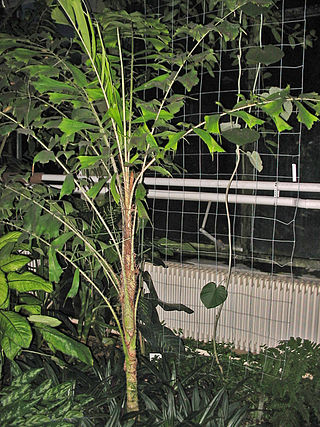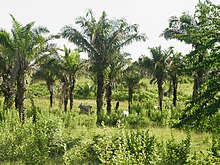
The Arecaceae is a family of perennial, flowering plants in the monocot order Arecales. Their growth form can be climbers, shrubs, tree-like and stemless plants, all commonly known as palms. Those having a tree-like form are called palm trees. Currently, 181 genera with around 2,600 species are known, most of which are restricted to tropical and subtropical climates. Most palms are distinguished by their large, compound, evergreen leaves, known as fronds, arranged at the top of an unbranched stem, except for the Hyphaene genus, who has branched palms. However, palms exhibit an enormous diversity in physical characteristics and inhabit nearly every type of habitat within their range, from rainforests to deserts.

Lodoicea, commonly known as the sea coconut, coco de mer, or double coconut, is a monotypic genus in the palm family. The sole species, Lodoicea maldivica, is endemic to the islands of Praslin and Curieuse in the Seychelles. It has the largest seed in the plant kingdom. It was also formerly found on the small islets of St Pierre, Chauve-Souris, and Ile Ronde, all located near Praslin, but had become extinct there for a time until recently reintroduced.

Heart of palm is a vegetable harvested from the inner core and growing bud of certain palm trees, most notably the coconut, juçara, açaí palm, palmetto, and peach palm. Harvesting of many uncultivated or wild single-stemmed palms results in palm tree death. However, other palm species are clonal or multi-stemmed plants, and moderate harvesting will not kill the entire clonal palm. Heart of palm may be eaten on its own, and often it is eaten in a salad.

Bactris gasipaes is a species of palm native to the tropical forests of Central and South America. It is well spread in these regions, where it is often cultivated by smallholders in agroforestry systems or more rarely, in monoculture. Common names include peach palm in English, among others used in South American countries. It is a long-lived perennial plant that is productive for 50 to 75 years on average. Its population has an important genetic diversity, leading to numerous fruits, colors, and qualities. The fruits are edible and nutritious but need to be cooked for 30 minutes to five hours. They also benefit many animals in the wild. Peach-palms are also cultivated for the heart of palm, and the trunk can make valuable timber.

Attalea maripa, commonly called maripa palm is a palm native to tropical South America and Trinidad and Tobago. It grows up 35 m (115 ft) tall and can have leaves or fronds 10–12 m (33–39 ft) long. This plant has a yellow edible fruit which is oblong ovoid and cream. An edible oil can be extracted from the pulp of the fruit and from the kernel of the seed.

Aiphanes is a genus of spiny palms which is native to tropical regions of South and Central America and the Caribbean. There are about 26 species in the genus, ranging in size from understorey shrubs with subterranean stems to subcanopy trees as tall as 20 metres (66 ft). Most have pinnately compound leaves ; one species has entire leaves. Stems, leaves and sometimes even the fruit are covered with spines. Plants flower repeatedly over the course of their lifespan and have separate male and female flowers, although these are borne together on the same inflorescence. Although records of pollinators are limited, most species appear to be pollinated by insects. The fruit are eaten by several birds and mammals, including at least two species of amazon parrots.

Chamaerops is a genus of flowering plants in the family Arecaceae. It contains only one species, Chamaerops humilis, variously called European fan palm or the Mediterranean dwarf palm. It is one of the most cold-hardy palms and is used in landscaping in temperate climates.

Iriartea is a genus in the palm family Arecaceae, native to Central and South America. The best-known species – and probably the only one – is Iriartea deltoidea, which is found from Nicaragua, south into Bolivia and a great portion of Western Amazonian basin. It is the most common tree in many forests in which it occurs.

Syagrus romanzoffiana, the queen palm or cocos palm, is a palm native to South America, introduced throughout the world as a popular ornamental garden tree. S. romanzoffiana is a medium-sized palm, quickly reaching maturity at a height of up to 15 m (49 ft) tall, with pinnate leaves having as many as 494 pinnae (leaflets), although more typically around 300, each pinna being around 50 centimetres (18 in) in length and 3–5 centimetres (1–2 in) in width.

Aiphanes horrida is a palm native to northern South America and Trinidad and Tobago. Aiphanes horrida is a solitary, spiny tree. In the wild it grows 3–10 metres tall tall with a stem diameter of 6–10 centimetres ; cultivated trees may be as much as 15 m (49') tall with a 15 cm (6") diameter. The epicarp and mesocarp of the fruit are rich in carotene and are eaten in Colombia, while the seeds are used to make candles. In parts of the Colombian Llanos, endocarps are used to play games.

Attalea speciosa, the babassu, babassu palm, babaçu, or cusi, is a palm native to the Amazon Rainforest region in South America. The babassu palm is the predominant species in the Maranhão Babaçu forests of Maranhão and Piauí states.

Attalea is a large genus of palms native to Mexico, the Caribbean, Central and South America. This pinnately-leaved, non-spiny genus includes both small palms lacking an aboveground stem and large trees. The genus has a complicated taxonomic history, and has often been split into four or five genera based on differences in the male flowers. Since the genera can only be distinguished on the basis of their male flowers, the existence of intermediate flower types and the existence of hybrids between different genera has been used as an argument for keeping them all in the same genus. This has been supported by recent molecular phylogenies.

Butia purpurascens is a smallish, relatively slender, endangered species of Butia palm, up to 3-7m tall. It is locally known as palmeira-jataí, coqueiro-de-vassoura, butiá or coquinho-azedo in Portuguese. The Kalunga people call this palm cabeçudo.

Ceroxylon is a genus of flowering plants in the family Arecaceae, native to the Andes in Venezuela, Colombia, Ecuador, Peru, and Bolivia, known as Andean wax palms.

Phytelephas seemannii, commonly called Panama ivory palm, is a species of flowering plant in the family Arecaceae. It is one of the plants used for vegetable ivory.

Psittacanthus, also parrot-flower, is a plant genus in the family Loranthaceae. It is a type of mistletoe native from central Mexico southwards to Central America and parts of South America.

Copernicia macroglossa, is a species of palm endemic to western and central Cuba.

Evolutionary anachronism, also known as "ecological anachronism", is a term initially referring to attributes of native plant species that seemed best explained as having been favorably selected in the past due to their coevolution with plant-eating megafauna that are now extinct. Diminished effectiveness and distance of seed dispersal by fruit-eating mammals inhabiting the same ecosystems today suggest maladaptation. Maladaptation of such fruiting plants will intensify as ongoing climate change shifts the physical and ecological conditions within their current geographic range.

Astrocaryum standleyanum is a species of palm known by many common names, including chumba wumba, black palm, chonta, chontadura, coquillo, palma negra, pejibaye de montaña, güerre, güérregue, güinul, mocora, pucaishchi (Chachi), and chunga (Emberá). It is native to Central and South America, where its distribution extends from Nicaragua to Ecuador. It is most common in central Panama, even becoming abundant in the tropical forests around the Panama Canal, but in general it is not a common plant.

Attalea dubia, also known as the Indaiá plant, babassu palm, or bacuaçu palm is a flowering plant in the family Arecaceae, native to the Southern and Southeast Regions of Brazil.



















